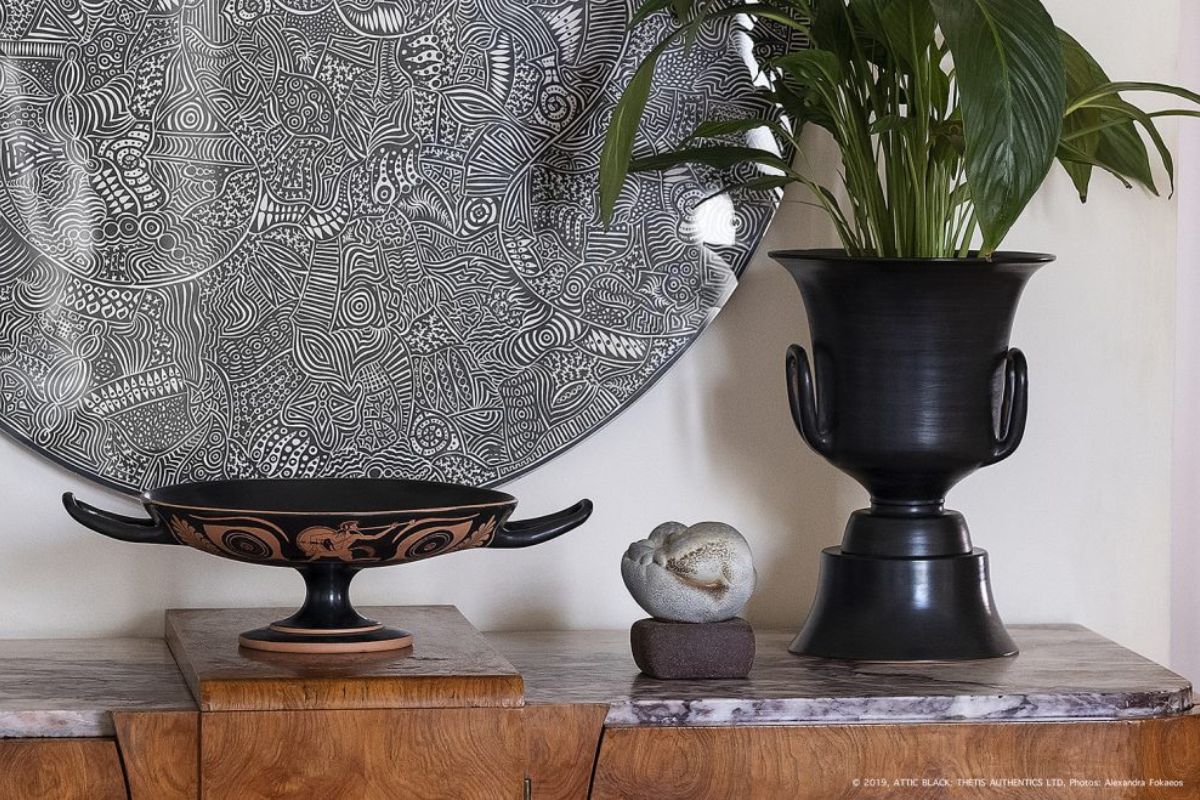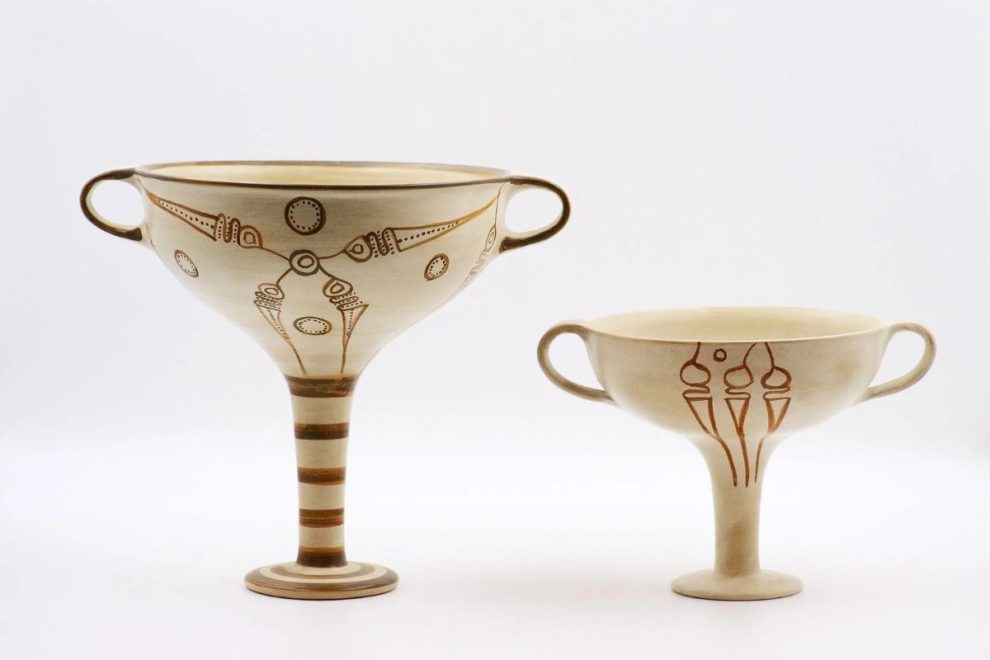
Step back into ancient Greece, where wine, art, and socializing came together in interesting ways.
Key Highlights
- Ancient Greek artisans designed kylix pottery as a distinctive wide-bowled drinking cup for serving wine during symposiums.
- They often decorated these cups with detailed imagery, such as mythological scenes, humorous content, or symbolic motifs that appeared as the drink was consumed.
- Artisans crafted kylikes using ceramics, with some pottery types displaying exquisite craftsmanship and unique designs like offset lips and adorned tondos.
- The horizontal handles of kylikes facilitated drinking and games like kottabos at social gatherings.
- Renowned painters, such as Douris and Onesimos, contributed artwork that reflected the cultural and mythological narratives of ancient Greece.
One key item was the kylix, an ancient Greek pottery piece known as the cup. It was not just a drink container but also a canvas for stories. It showed themes from mythology, humor, and everyday life. Kylikes were mostly used during symposiums. They captured the spirit of good company and great skills. With horizontal handles and a unique design, the kylix remains a lasting symbol of ancient Greek culture and art — a true example of kylix pottery.

The History and Origin of Kylix Pottery
The kylix is a cup with deep roots in ancient Greece. It started in the Mycenaean period and was popular in classical Athens. Over the years, its designs changed. These changes showed local styles and different times, with each having its own unique look. Kylikes were not just common in Greece. They were also popular in Etruscan places and became important exports. They were linked to symposiums, where people gathered to drink and talk. The designs on kylikes showed themes like mythology, humor, and social customs. Now, let’s look closer at the specifics of kylix pottery.
What is Kylix Pottery?
The kylix is a famous piece of ancient Greek pottery. It is known mainly as a drinking cup for wine. The cup has a wide bowl, a thin stem, and two horizontal handles. It was both useful and beautiful for parties called symposiums. Its wide base kept it steady. The design made it easy to use, even when lying down. Artisans placed a circle at the bottom inside the cup called a tondo. As people drank the wine, they saw detailed artwork. These designs often show lively images of mythological heroes or scenes from everyday life. Each sip became a visual treat. The kylix was not just a drinking cup. It was also a sign of artistic skill. Ancient Greek potters used it not only for drinking but also for telling stories. They showed their culture, talent, and craftsmanship. Next, we will look closer at its importance in culture.
Historical Significance of Kylix Pottery in Ancient Greece
In ancient Greece, the kylix was very important during social gatherings called symposiums. These events were a time for friendship and conversations about philosophy, politics, and mythology, all while enjoying wine. In Athens, kylikes often showed images related to the worship of Dionysus, the god of wine, or pictures of Zeus. The designs included fun themes and sea scenes that matched stories comparing symposiums to sailing. These creative designs made the events visually appealing and culturally rich. The kylix’s shape was also practical for drinking during symposiums. Its horizontal handles were useful and allowed for party games like kottabos, where people flicked wine dregs at a target. These features made the kylix a must-have in Greek social events. Now, let’s look at how its design added a touch of beauty.

Design Elements of Kylix Pottery
Kylix pottery was known for its beautiful and practical design. It combined style with usefulness. The round cup sat on a thin stem and had two horizontal handles. This made it easy to hold and drink from during gatherings. A distictive feature was the tondo at the bottom of the inner basin. It often showed vivid images, making the cup feel like a small art gallery. The outside was also decorated with painted friezes, showing scenes from mythology and everyday life. Now, let’s explore the motifs and symbols seen on these cups.
Common Motifs and Symbols
Kylix pottery is well-known for its beautiful designs. The artwork on these cups gave them an exceptional elegance. The decorations showed the culture and symbols of ancient Greece, including:
- Mythological stories: Many kylikes had images of legends, like Dionysus’ fun parties or Zeus’ victories.
- Daily activities: Some cup designs showed funny or light scenes from gatherings or sea trips.
- Symbolism: Roosters and other animals were often portrayed. They might have represented friendships or pastimes, like cockfighting.
- Explicit or satirical themes: Some kylikes featured surprising images that were either sexually suggestive or humorous to entertain guests.
These designs were not just pretty pictures; they told stories that entertained people. Next, we will look at the materials and methods used to create such remarkable art.
Materials and Techniques Used
Kylix pottery is mainly made from ceramics. It was strong and made symposium tables look nice. These ceramic cups were shaped like fancy metal ones but were used by everyday people.
The way they were made included filling pores with slip to give a smooth finish. This method helped keep liquid in without any leaking. Potters used careful methods, switching between black-figure and red-figure painting styles. This was especially seen on tondos and the outside parts of the cups. Applying slip let them create bright, contrasting designs.
In conclusion, Kylix pottery is not just an amazing example of ancient Greek culture. It also shows the social and time-related ceremonies of that era. The detailed designs, interesting history, and special craftsmanship make these wine cups fun for art lovers and historians. When we learn about the importance of Kylix pottery, we understand more about the life and beliefs of ancient Greeks. If you want to know more about ancient art or grow your collection, feel free to ask for help.
